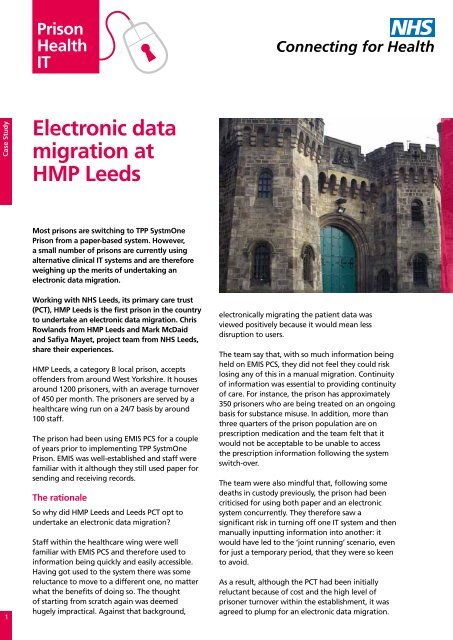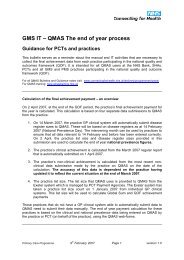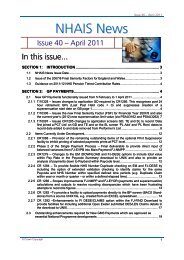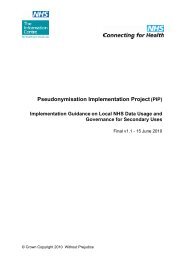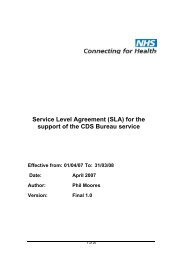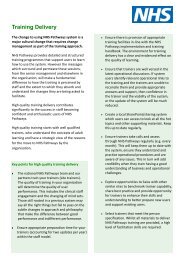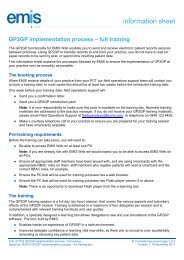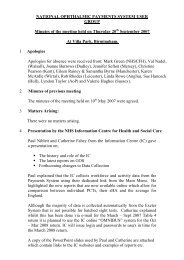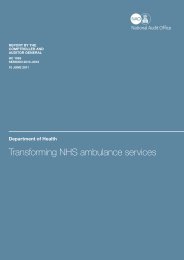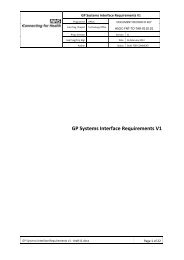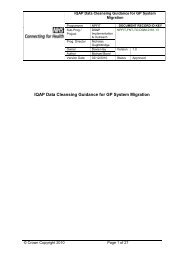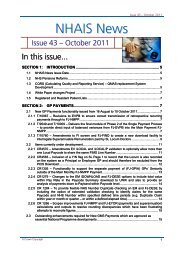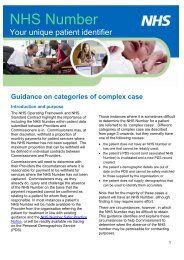Electronic data migration at HMP Leeds - NHS Connecting for Health
Electronic data migration at HMP Leeds - NHS Connecting for Health
Electronic data migration at HMP Leeds - NHS Connecting for Health
Create successful ePaper yourself
Turn your PDF publications into a flip-book with our unique Google optimized e-Paper software.
Prison<br />
<strong>Health</strong><br />
IT<br />
Case Study<br />
<strong>Electronic</strong> <strong>d<strong>at</strong>a</strong><br />
<strong>migr<strong>at</strong>ion</strong> <strong>at</strong><br />
<strong>HMP</strong> <strong>Leeds</strong><br />
Most prisons are switching to TPP SystmOne<br />
Prison from a paper-based system. However,<br />
a small number of prisons are currently using<br />
altern<strong>at</strong>ive clinical IT systems and are there<strong>for</strong>e<br />
weighing up the merits of undertaking an<br />
electronic <strong>d<strong>at</strong>a</strong> <strong>migr<strong>at</strong>ion</strong>.<br />
1<br />
Working with <strong>NHS</strong> <strong>Leeds</strong>, its primary care trust<br />
(PCT), <strong>HMP</strong> <strong>Leeds</strong> is the first prison in the country<br />
to undertake an electronic <strong>d<strong>at</strong>a</strong> <strong>migr<strong>at</strong>ion</strong>. Chris<br />
Rowlands from <strong>HMP</strong> <strong>Leeds</strong> and Mark McDaid<br />
and Safiya Mayet, project team from <strong>NHS</strong> <strong>Leeds</strong>,<br />
share their experiences.<br />
<strong>HMP</strong> <strong>Leeds</strong>, a c<strong>at</strong>egory B local prison, accepts<br />
offenders from around West Yorkshire. It houses<br />
around 1200 prisoners, with an average turnover<br />
of 450 per month. The prisoners are served by a<br />
healthcare wing run on a 24/7 basis by around<br />
100 staff.<br />
The prison had been using EMIS PCS <strong>for</strong> a couple<br />
of years prior to implementing TPP SystmOne<br />
Prison. EMIS was well-established and staff were<br />
familiar with it although they still used paper <strong>for</strong><br />
sending and receiving records.<br />
The r<strong>at</strong>ionale<br />
So why did <strong>HMP</strong> <strong>Leeds</strong> and <strong>Leeds</strong> PCT opt to<br />
undertake an electronic <strong>d<strong>at</strong>a</strong> <strong>migr<strong>at</strong>ion</strong>?<br />
Staff within the healthcare wing were well<br />
familiar with EMIS PCS and there<strong>for</strong>e used to<br />
in<strong>for</strong>m<strong>at</strong>ion being quickly and easily accessible.<br />
Having got used to the system there was some<br />
reluctance to move to a different one, no m<strong>at</strong>ter<br />
wh<strong>at</strong> the benefits of doing so. The thought<br />
of starting from scr<strong>at</strong>ch again was deemed<br />
hugely impractical. Against th<strong>at</strong> background,<br />
electronically migr<strong>at</strong>ing the p<strong>at</strong>ient <strong>d<strong>at</strong>a</strong> was<br />
viewed positively because it would mean less<br />
disruption to users.<br />
The team say th<strong>at</strong>, with so much in<strong>for</strong>m<strong>at</strong>ion being<br />
held on EMIS PCS, they did not feel they could risk<br />
losing any of this in a manual <strong>migr<strong>at</strong>ion</strong>. Continuity<br />
of in<strong>for</strong>m<strong>at</strong>ion was essential to providing continuity<br />
of care. For instance, the prison has approxim<strong>at</strong>ely<br />
350 prisoners who are being tre<strong>at</strong>ed on an ongoing<br />
basis <strong>for</strong> substance misuse. In addition, more than<br />
three quarters of the prison popul<strong>at</strong>ion are on<br />
prescription medic<strong>at</strong>ion and the team felt th<strong>at</strong> it<br />
would not be acceptable to be unable to access<br />
the prescription in<strong>for</strong>m<strong>at</strong>ion following the system<br />
switch-over.<br />
The team were also mindful th<strong>at</strong>, following some<br />
de<strong>at</strong>hs in custody previously, the prison had been<br />
criticised <strong>for</strong> using both paper and an electronic<br />
system concurrently. They there<strong>for</strong>e saw a<br />
significant risk in turning off one IT system and then<br />
manually inputting in<strong>for</strong>m<strong>at</strong>ion into another: it<br />
would have led to the ‘joint running’ scenario, even<br />
<strong>for</strong> just a temporary period, th<strong>at</strong> they were so keen<br />
to avoid.<br />
As a result, although the PCT had been initially<br />
reluctant because of cost and the high level of<br />
prisoner turnover within the establishment, it was<br />
agreed to plump <strong>for</strong> an electronic <strong>d<strong>at</strong>a</strong> <strong>migr<strong>at</strong>ion</strong>.
Prison<br />
<strong>Health</strong><br />
IT<br />
Case Study<br />
The process<br />
On paper the actual <strong>d<strong>at</strong>a</strong> <strong>migr<strong>at</strong>ion</strong> process<br />
looked straight<strong>for</strong>ward. However, there were<br />
certain practical challenges th<strong>at</strong> needed to be<br />
overcome.<br />
The first step was <strong>for</strong> CSC/TPP to take a <strong>d<strong>at</strong>a</strong><br />
extract from EMIS PCS. Chris reviewed the<br />
extract, making sure th<strong>at</strong> it was represent<strong>at</strong>ive of<br />
the healthcare wing’s caseload.<br />
The extracted <strong>d<strong>at</strong>a</strong> was then put into a dummy<br />
version of TPP SystmOne Prison and checked <strong>for</strong><br />
accuracy. Although this was done initially by TPP<br />
they needed to ask Chris questions about the<br />
extract, so th<strong>at</strong> records could be ‘mapped across’.<br />
Working on-site <strong>at</strong> the prison, the healthcare<br />
team – chiefly Chris – got steadily more involved<br />
in checking and qualifying a cross-section of the<br />
<strong>d<strong>at</strong>a</strong> in the dummy system. The extract was then<br />
signed-off.<br />
At this stage a final extract from EMIS PCS was<br />
taken and migr<strong>at</strong>ed onto the TPP SystmOne<br />
Prison. The healthcare team then had 11 days<br />
between the extract being taken and TPP<br />
SystmOne Prison going live (although seven days<br />
is considered achievable) and reverted back to<br />
paper during this period.<br />
<strong>Leeds</strong> were happy with the quality of records<br />
they had after the <strong>migr<strong>at</strong>ion</strong>. They found th<strong>at</strong> all<br />
the in<strong>for</strong>m<strong>at</strong>ion was where it should be, and th<strong>at</strong><br />
it was all accur<strong>at</strong>e and to the standard expected.<br />
All the prescriptions were fine. “As long as the<br />
<strong>d<strong>at</strong>a</strong> was read coded it migr<strong>at</strong>ed OK to TPP<br />
SystmOne Prison,” says Chris. “But clearly, the<br />
<strong>d<strong>at</strong>a</strong> migr<strong>at</strong>ed can only ever be as good as the<br />
<strong>d<strong>at</strong>a</strong> held in the original system.”<br />
Templ<strong>at</strong>es were not migr<strong>at</strong>ed. These needed to<br />
be re-cre<strong>at</strong>ed in TPP SystmOne Prison, where<br />
there was not already a standard templ<strong>at</strong>e in the<br />
system.<br />
Lessons learned<br />
So wh<strong>at</strong> lessons were learned during this process?<br />
The team say th<strong>at</strong> above all, a dedic<strong>at</strong>ed member<br />
of staff is needed within the healthcare team to<br />
lead on the <strong>d<strong>at</strong>a</strong> <strong>migr<strong>at</strong>ion</strong>, liaising with both<br />
CSC/TPP and the PCT, and ensuring th<strong>at</strong> <strong>d<strong>at</strong>a</strong><br />
checking happens in a timely manner.<br />
It needs to be tre<strong>at</strong>ed very much as a project in its<br />
own right, they say, with a proper plan in place.<br />
Every individual involved needs to understand<br />
how the process will work and wh<strong>at</strong> is expected<br />
of them and when.<br />
In terms of timescales, <strong>d<strong>at</strong>a</strong> <strong>migr<strong>at</strong>ion</strong> was<br />
meant to increase the deployment process <strong>for</strong><br />
TPP SystmOne Prison to 16 weeks but <strong>Leeds</strong><br />
made a conscious decision to go <strong>for</strong> 20 weeks.<br />
The feeling within the team is th<strong>at</strong> the act of<br />
migr<strong>at</strong>ing the <strong>d<strong>at</strong>a</strong> is not too much of an issue,<br />
it’s the training and business change activities<br />
which are time-consuming.<br />
Resource also needs to be made available within<br />
the healthcare team to support the <strong>d<strong>at</strong>a</strong> checking<br />
process. Based on their own experiences, Chris<br />
and Safiya believe th<strong>at</strong> the ideal would have<br />
been to have <strong>at</strong> least three members of staff<br />
available to help with this task, each with their<br />
own terminals to work <strong>at</strong>.<br />
They and Mark also say th<strong>at</strong> serious consider<strong>at</strong>ion<br />
needs to be given to backfilling <strong>for</strong> staff who are<br />
helping with the project. And, as far as possible,<br />
staff changes which may take place during the<br />
<strong>d<strong>at</strong>a</strong> <strong>migr<strong>at</strong>ion</strong> and wider deployment process<br />
need to be anticip<strong>at</strong>ed, alongside issues such as<br />
annual leave.<br />
They also say th<strong>at</strong> system knowledge is<br />
important. <strong>Health</strong>care staff supporting the<br />
electronic <strong>d<strong>at</strong>a</strong> <strong>migr<strong>at</strong>ion</strong> need to have a good<br />
knowledge both of the old system and TPP<br />
SystmOne Prison. The team say th<strong>at</strong> without<br />
this knowledge the <strong>d<strong>at</strong>a</strong> checking will take a lot<br />
longer.<br />
2
Prison<br />
<strong>Health</strong><br />
IT<br />
Case Study<br />
There was also the simple issue of communic<strong>at</strong>ion<br />
and access. Chris admits th<strong>at</strong>, <strong>at</strong> times, TPP found<br />
it difficult to get in touch with her. As she was<br />
the person most involved in verifying the <strong>d<strong>at</strong>a</strong><br />
this served to lengthen the timescales <strong>for</strong> the<br />
<strong>d<strong>at</strong>a</strong> <strong>migr<strong>at</strong>ion</strong>. She says th<strong>at</strong> establishing fast<br />
and effective communic<strong>at</strong>ion routes with both<br />
the supplier and PCT is essential.<br />
Mark adds: “And, if problems occur during<br />
either the electronic <strong>d<strong>at</strong>a</strong> <strong>migr<strong>at</strong>ion</strong> and wider<br />
implement<strong>at</strong>ion, it’s important to stick to the<br />
process with the project team and escal<strong>at</strong>e the<br />
issues via the correct route.”<br />
Final reflections<br />
Looking back, Chris, Safiya and Mark all believe<br />
th<strong>at</strong> electronic <strong>d<strong>at</strong>a</strong> <strong>migr<strong>at</strong>ion</strong> was the right<br />
decision <strong>for</strong> <strong>HMP</strong> <strong>Leeds</strong>. It was based logically on<br />
key factors including level of usage of the current<br />
system (in this case, EMIS PCS), quality of <strong>d<strong>at</strong>a</strong><br />
on the system and whether and how paper was<br />
being used.<br />
Despite the challenges they feel th<strong>at</strong><br />
summarising from paper would have been just as<br />
challenging, if not more so, and perhaps prone<br />
to error.<br />
Thinking about the business change issues, the<br />
team also accept th<strong>at</strong>, given the initial reluctance<br />
of some staff to switch to the new system, more<br />
could have been done to promote the benefits of<br />
TPP SystmOne Prison. They feel th<strong>at</strong> some specific<br />
benefits to highlight would have been the ability<br />
to share prisons’ records across establishments,<br />
the reporting functionality in the system and the<br />
ability to take uploads from LIDS.<br />
They also say th<strong>at</strong>, although high turnover of<br />
prisoners might be seen as an argument against<br />
electronic <strong>d<strong>at</strong>a</strong> <strong>migr<strong>at</strong>ion</strong>, <strong>HMP</strong> <strong>Leeds</strong> has a lot of<br />
prisoners who leave the prison and then return.<br />
The amount of prisoner turnover in the period<br />
between the final <strong>d<strong>at</strong>a</strong> extract being taken,<br />
and the system going live, was not substantial<br />
enough <strong>for</strong> them to change this view.<br />
They do say, though, th<strong>at</strong> following the<br />
implement<strong>at</strong>ion staff have adapted to TPP<br />
SystmOne Prison very quickly. This is partly down<br />
to having enough super-users in place who can<br />
support other members of staff. “We have 20<br />
super users – one <strong>for</strong> every department within<br />
the healthcare wing,” says Chris. “All band 7<br />
staff were super users, as were all the GPs. We<br />
thought this was essential given we’re a 24/7<br />
oper<strong>at</strong>ion.”<br />
<strong>NHS</strong> <strong>Connecting</strong> <strong>for</strong> <strong>Health</strong> is the n<strong>at</strong>ional<br />
organis<strong>at</strong>ion which is supporting your<br />
local <strong>NHS</strong> to introduce new computer<br />
systems and services. These will help<br />
deliver better, safer care <strong>for</strong> <strong>NHS</strong> p<strong>at</strong>ients.<br />
For more in<strong>for</strong>m<strong>at</strong>ion about this, visit:<br />
www.connecting<strong>for</strong>health.nhs.uk<br />
3<br />
4509 (April 2010)


